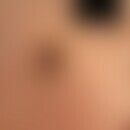Synonym(e)
Definition
Seltenes, chronisch rezidivierendes Krankheitsbild mit schweren Angioödemen, Urtikaria und oft sehr hoher peripherer (primärer) Eosinophilie (bis > 50.000/ul).
Auch interessant
Ätiopathogenese
Ungeklärt; nachgewiesen sind T-Zell-Defekte und Funktionsstörungen der eosinophilen Granulozyten. Auch nach Einnahme von ACE-Hemmern aufgetreten.
Klinisches Bild
Meist dramatisch verlaufende, rezidivierende (monatliche Intervalle; auch öfters), schwerste Schwellungszustände an Gesicht, Nacken, Extremitäten und Stamm. Diese episodischen Angioödeme können kombiniert sein mit hohen Fieberschüben, Arthralgien, Gewichtsverlust. Die Schübe können auch nach Infekten auftreten.
Differentialdiagnose
Hereditäre Angioödeme
Nichtepisodische erworbene Angioödeme (ohne Eosinophilie)
nonepisodisches Angioödem mit Eosinophilie
Therapie
Das Krankheitsbild spricht gut auf höhere und mittlere Dosen von Glukokortikoiden (z.B. Prednisolon 1,0-1,5 mg/kg KG/Tag) an.
Vereinzelt wurden auch Erfolge mit IVIG beschrieben.
Fallberichte:
- Suplatast tosilate: Ein Fallbericht liegt über Effekte mit "Suplatast tosilate" einem anti-allergisch wirksamen Th2 Zytokininhibitor vor.
- Imatinibmesylat: Die Anwendung von Imatinibmesylat (s.u. Imatinib), zunächst als steroidsparendes Mittel und später als Erhaltungsmedikation, zusammen mit niedrig dosiertem Prednison führte zu einer langfristigen Kontrolle der Hypereosinophilie und aller klinischen Manifestationen (Butterfield JH 2021).
Hinweis(e)
Ein klinisch ähnliches Krankheitsbild wird mit dem " Capillary-Leak-Syndrome" bei der Behandlung maligner Tumoren mit Interleukin-2 gesehen. Es bestehen enge Beziehungen zum Hypereosinophilie-Syndrom. In Einzelfällen traten episodische eosinophile Angioödeme im Zusammenhang mit der Einnahme von ACE-Hemmern (s.u. Eosinophilie) auf. Basso JR et al. (2021) beschrieben das Syndrom zusammen mit Urtikariavaskulitis.
LiteraturFür Zugriff auf PubMed Studien mit nur einem Klick empfehlen wir  Kopernio
Kopernio
 Kopernio
Kopernio- Abouzahir A et al. (2005) Gleich syndrome. A case report and review of the literature. Rev Med Interne 26: 137-140
- Banerji A et al. (2006) Cytokine-associated angioedema syndromes including episodic angioedema with eosinophilia (Gleich's Syndrome). Immunol Allergy Clin North Am 26: 769-81
- Basso JR et al. (2021) Episodic angioedema with eosinophilia (Gleich's syndrome) associated with urticarial vasculitis: a coincidence or a novel clinical entity? Braz J Med Biol Res 54:e10745.
- Butterfield JH (2021) Successful Long-Term Control of the Syndrome of Episodic Angioedema With Eosinophilia (Gleich Syndrome) With Low-Dose Imatinib Mesylate and Prednisone. J Investig Med High Impact Case Rep 2324709620987691.
- Gleich GJ, Schroeter AL, Marcoux JP, Sachs MI, O'Connell EJ, Kohler PF (1984) Episodic angioedema associated with eosinophilia. Trans Assoc Am Physicians. 97: 25-32
- Hashizume H et al. (2014) Treatment of non-episodic angioedema associated with eosinophilia with suplatast tosilate, an anti-allergic selective Th2 cytokine inhibitor. Eur J Dermatol 24:250-252
- Motegi S et al. (2013) Elevated serum levels of TARC/CCL17, eotaxin-3/CCL26 and vascular endothelial growth factor in a patient with non-episodic angioedema associated with eosinophilia and granulomatous cutaneous reaction. Eur J Dermatol 23:524-526
- Panaszek B et al. (2003) Blood and tissue eosinophilia in patient with angioedema caused by inhibitor of angiotensin converting enzyme (ACE). Pol Arch Med Wewn 110: 1339- 1343
- Stockner I et al. (2008) Non-episodic angioedema associated with eosinophilia following Mycoplasma pneumoniae infection. Clin Rheumatol 27:1573-1576
Verweisende Artikel (3)
Capillary-Leak-Syndrom; Eosinophilie, Hautveränderungen; Hypereosinophilie-Syndrom;Weiterführende Artikel (10)
ACE-Hemmer; Angioödeme erworbene; Capillary-Leak-Syndrom; Eosinophilie, Hautveränderungen; Hypereosinophilie-Syndrom; Imatinib; Interleukin-2-Therapie; IVIG; Suplatast tosilate; Urtikariavaskulitis;Disclaimer
Bitte fragen Sie Ihren betreuenden Arzt, um eine endgültige und belastbare Diagnose zu erhalten. Diese Webseite kann Ihnen nur einen Anhaltspunkt liefern.




